
Adwick le Street is a village in the City of Doncaster, South Yorkshire, England. The Adwick ward of Doncaster Metropolitan Borough Council had a population of 15,911 at the 2011 Census. It is situated north-west of Doncaster. Under the 2011 census, the settlement had a population of 10,507.

Skellow is a village in the Doncaster district, in the county of South Yorkshire, England. Historically part of the West Riding of Yorkshire, the village is roughly 5 miles (8 km) north-west of Doncaster. The village falls in the Askern Spa Ward of Doncaster MBC. To the north and south is mixed farmland, the A1 runs immediately along the western edge of the village, and to the east Skellow merges with the adjacent village of Carcroft along the B1220 road.

Pickering Castle is a motte-and-bailey fortification in Pickering, North Yorkshire, England. The original castle was made of timber, and the later stone castle was a temporary prison for Richard II in 1399.
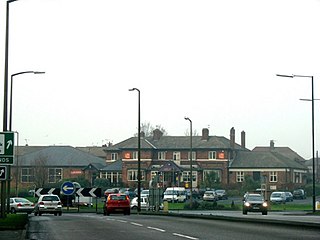
Highfields is a former coal mining village, located south of the model village of Woodlands, in South Yorkshire. Historically part of the West Riding of Yorkshire, it is part of the City of Doncaster. The village is located in the Adwick ward of Doncaster MBC.
Castle Hill is a scheduled ancient monument in Almondbury overlooking Huddersfield in the Metropolitan Borough of Kirklees, West Yorkshire, England. The hilltop has been settled for at least 4,000 years. The scheduled monument comprises the remains of a late-Bronze Age or early Iron Age univallate hillfort with a single raised bank, a later Iron Age multivallate hillfort, a 12th-century motte-and-bailey castle, and the site of a deserted medieval village. The grade II listed Victoria Tower on the summit of Castle Hill is by far the most conspicuous landmark in Huddersfield. The hill has been a place of recreation for hundreds of years and the easily discernible remains of past occupation have made it a subject for legend, speculation and scientific study. It is located on UK Maps at grid reference SE152140.

Bardsey, West Yorkshire, England is a small village in the City of Leeds metropolitan borough, 8 miles (13 km) north east of Leeds city centre. The village is in the LS17 Leeds postcode district. It is part of the civil parish of Bardsey cum Rigton. The village itself lies just off the A58 road between Leeds and Wetherby.
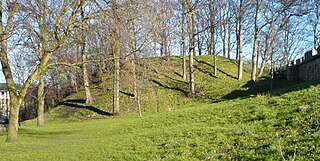
Baile Hill is a man-made earth mound in the Bishophill area of York, England. It is the only remaining feature of what was known as the Old Baile.

Aslockton Castle is a ruined fortification, a motte-and-bailey castle, in the village of Aslockton, Nottinghamshire. The original name of the settlement was Aslachetone, which suggests a possible Norse origin; it was mentioned in the Domesday Book of 1086 where it was described as a large settlement.
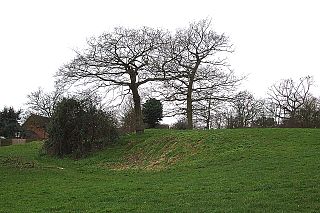
Flitwick Castle was an 11th-century castle located in the town of Flitwick, in the county of Bedfordshire, England.
Watch Hill Castle is a medieval motte-and-bailey on the boundary of Bowdon and Dunham Massey, Greater Manchester, England. It is a scheduled monument. The castle is located north of the River Bollin and south of a deep ravine.
Rochdale Castle was a motte-and-bailey castle in Rochdale, Greater Manchester, England. It was built in the period shortly after the Norman conquest of England.

While there are many castles in South Yorkshire, the majority are manor houses and motte-and-bailey which were commonly found in England after the Norman Conquest.

Tickhill Castle was a castle in Tickhill, in South Yorkshire, England and a prominent stronghold during the reign of King John.
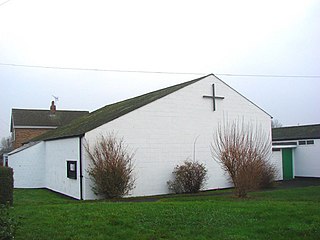
Scawthorpe is a suburb of Doncaster in South Yorkshire, England on the A638 road. It is split between the city council wards of Roman Ridge and Bentley.
Castle Nimble was a motte and bailey defensive fortification near Old Radnor, in Radnorshire, Wales. Castle Nimble appears to have had an oval-shaped ditched motte, with a semi-rectangular bailey, and some other enclosures, including possibly a pond.
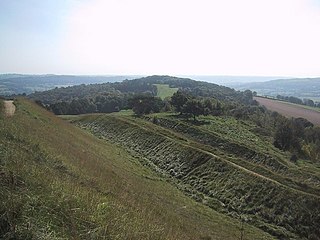
Kimsbury hill fort, also known as Castle Godwyn, Kimsbury Camp, Painswick Beacon or Painswick hill fort is an Iron Age hill fort on Painswick Beacon near Painswick in the Cotswolds, Gloucestershire England.

The Skipsea meres were three lakes in and around the village of Skipsea in the East Riding of Yorkshire, England. The meres that are known to have existed were Skipsea Bail Mere, Skipsea Low Mere and Skipsea Withow Mere. The name of the village, Skipsea, means lake, or harbour for ships.

Pinxton Castle, Derbyshire, is a scheduled monument in Castle Wood that straddles Pinxton and South Normanton. In its designation as a scheduled monument, Historic England describes it as having been a motte and fortified manor, with a moated site and five fishponds. Unlike most of the about 6000 moated sites in England, a large fortified enclosure surrounded the moat.














